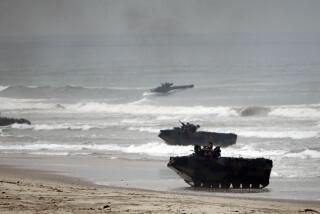Marines Recall Historic March to Camp Pendleton
- Share via
When Marine Corps Sgt. Charles Nicholson strapped on his 60-pound pack at Camp Elliott on Sept. 1, 1942, and fell into formation for a four-day hike to the new Camp Pendleton, no band played a send-off. No dignitaries declared the moment historic.
“It was just a hike. We were just going from one place to the other,” recalled Nicholson, now a 71-year-old retired lieutenant colonel.
But 50 years later, that hike has been written into Marine Corps history. The 3,500 Leathernecks of the 9th Marine Regiment who trudged through San Diego County’s dusty, brush-covered hills behind Camp Pendleton’s future commandant, Col. Lemuel Sheppard, became the first of thousands of Pendleton-trained fighters to carry the flag into four wars and several military actions.
In a ceremony Wednesday at the all-but-abandoned Camp Elliott on Kearny Mesa, the Marine Corps began a three-day commemoration of the march. This time a band was on hand. And a dignitary spoke a few well-chosen words.
“The march in 1942 perhaps was not as significant as the era that it began--the era of training aboard Camp Pendleton,” said Brig. Gen. B. Don Lynch, the base’s commander. Through its 50 years, he said, Camp Pendleton has become “one of the finest training bases this country has to offer.”
Then, as the band played, 125 Marines stepped off on the hike that took them across the brush-covered hills east of Miramar Naval Air Station under a blazing sun. Nicholson and Richard Goucher, a 78-year-old retired sergeant major who also participated in the first march, followed behind in a Marine Corps vehicle.
Watching the new era of Marines prompted the two veterans to reminisce about the first march.
With involvement in World War II imminent, their regiment had to be moved from the undersized Camp Elliott to the new 130,000-acre base near Oceanside where they could practice larger maneuvers. Their leader, Col. Sheppard (who died last year), used the march as a training exercise, treating the rough, rattlesnake-laced terrain as enemy territory.
“We did pretty close to 20 miles a day,” said Nicholson, who would go on to fight at Guadalcanal, Guam, Bougainville and Iwo Jima. “We were quite tired at the end of the day.”
But both said that the march was just part of the larger events that occupied their minds at the time. “It was all so new to us; we didn’t really know what was happening,” said Goucher, who was among the first waves of Marines to land at Bougainville and Guam.
Goucher remembered that the first day of the march was relatively short, with the regiment setting up camp near the Big Stone Lodge in Poway. Members of Goucher’s unit had enough energy to play softball that afternoon.
Wednesday’s hike for the 125 Marines was short, too. After three miles, they boarded trucks at the Naval and Marine Corps Reserve Center on Pomerado Road. From there, they rode into Poway and set up a display of infantry weapons and equipment for the students at Meadowbrook Middle School. They then packed up and drove to Felicita Park in Escondido, where they set up a similar display in the afternoon and evening.
Because what was open terrain a half century ago is now covered with highly traveled roads and subdivisions, little of the commemoration is being done on foot. Today the Marines travel by motorcade through San Marcos and Vista with stops at Palomar College and Vista’s Lincoln Middle School. Friday they roll through Bonsall and Fallbrook on their way back to Camp Pendleton for a parade and weekend events marking the 50th anniversary of the base’s dedication on Sept. 25, 1942.
Although details of the march that preceded the opening of Camp Pendleton remain fuzzy, both Goucher and Nicholson said they remember it as one of the key exercises that prepared them for war.
Months later, while stationed in New Zealand just before entering the fighting under Sheppard’s command, Nicholson said the hike across the San Diego County backcountry remained etched in their minds.
“Quite often,” Nicholson said, “we compared the hikes we took down there to the one we took to Camp Pendleton.”
More to Read
Sign up for Essential California
The most important California stories and recommendations in your inbox every morning.
You may occasionally receive promotional content from the Los Angeles Times.













